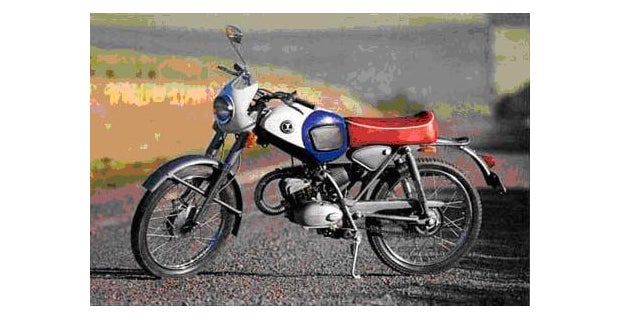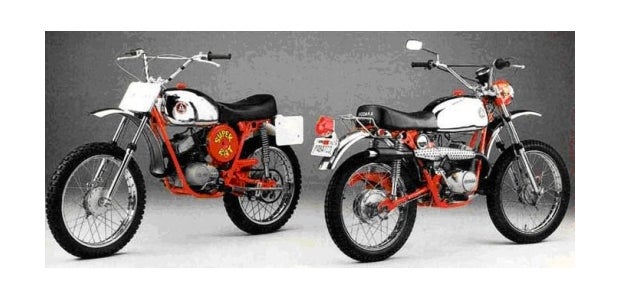
Remember the Hodaka? That chrome-toaster, gas-tanked little dirt bike that won the hearts and minds of US dirt riders back in the early 1970’s? Sure you do. While the Hodaka was a reliable, un-complicated small motorcycle, its history is anything but.
Raised from the ashes of the Yamaguchi motorcycle company (Fuji Motors) that closed in 1963, Hodaka was the first motorcycle company to utilize a Japanese motor installed in a U.S.-designed frame. A little background is in order to fully understand how this came about:
Pabatco was established in 1961 as a division of Farm Chemicals of Oregon, which distributed fertilizer throughout the Pacific Northwest. To create greater profits, genius company executives planned to trade locally grown produce to foreign countries for whatever products Pabatco could sell in the U.S. Back then, the Japanese needed the Yankee Dollar to buy U.S. produce, but by trading goods the currency issue was a moot point.
That program let Pabatco make an agreement with Yamaguchi Motorcycles, and soon motorcycles became Pabatco’s biggest business. By 1963, Pabatco had imported over 5000 Yamaguchis and distributed them through its 480 fertilizer and farm-implement dealers in exchange for farm produce and equipment. The sales of these bikes also created a new market for the lightweight two-stroke trail bike. The executives turned trail riders at Pabatco were jazzed and had machines back ordered for months, as supply couldn’t keep up with the demand.
But alas, in April of 1963, Yamaguchi went t!ts-up and left Pabatco the keys to an empty showrooom.

THE SUPER RAT & TRAIL VERSION 1971
Yamaguchi's insolvency not only screwed Pabatco, it also threatened to shut down the entire Hodaka Company of Nagoya, Japan, supplier of engines to Yamaguchi (pre Fuji Motors). To stop the bleeding, the execu-riders at Pabatco acted fast and asked themselves “why not build our own bike?” After all, they knew what the American trail rider wanted, and since Hodaka had 300 fully assembled motors sitting on the shop floor, they made a deal with Hodaka to re-tool and produce a motorcycle of Pabatco’s design.
By 1964, the first Pabatco-designed Hodaka rolled off the assembly line. It was sturdy, dependable, and for its time a fantastic trail bike that filled the needs of a growing market. The single-cylinder piston port two-stroke was named the Ace 90, and in addition to being dirt-worthy, it was street-legal, and could be ridden to the dirt rather than hauled on a trailer. Its $379 price tag also let the machine sell like hotcakes.
Believe it or not, Hodaka copied the Cotton frame, a double-down tube design that few motorcycles used at the time. Also, planned obsolescence was not to be at Hodaka, as the design team decided to refine existing models instead of introducing completely new machines every year. Also, you could have a Hodaka in any color as long as it was red.

The 1973 DIRT SQUIRT
In 1965, Shell Chemical, a division of the Royal Dutch Shell Oil Company, purchased Farm Chemicals of Oregon, Pabatco's parent company. What Shell didn’t understand at the time was that it now was a motorcycle manufacturer! The motorcycle division was profitable and growing, but it made the Shell executives nervous.
In June of 1966, the 10,000th Ace 90 was shipped from Nagoya – a fantastic achievement for a company that had almost closed its doors three years earlier. That same year, to display their faith in the Hodie, marketing manager Marvin Foster and sales VP Frank Wheeler rode a brace of Ace 90s on a 3800-mile tour of Baja, Mexico, without a single mechanical failure. Darn good stuff from a motorcycle company just three years old.
In 1970 Hodaka came out with a competition-only motorcycle, the Super Rat, and magazine testers went ape over the little red-and-chrome bikes. The bikes sold for less than $500.00 USD, and just like the CR125 Honda craze of 1973, the hills, tracks and forests were covered with little red-and-chrome dirt bikes.
In 1972 the 125 came out and was named the Wombat, with the dirt-only version being named the Combat Wombat. Hodaka sold these bikes with little modification or improvement for the next five years, when in 1977 Hodaka designed a 250cc trail bike and MX version called the “Thunder Dog.” They also sold a scaled-down version of the Super Rat, called the “Dirt Squirt” that had a racer clam insignia on the air cleaner cover. One could not fault Hodaka for giving boring names to their bikes, that’s for sure.
It all fell apart in 1979 when the value of the Yen went through the roof, and Japanese products were no longer so affordable in the USA. Shell tried to purchase Fuji Motors but failed, and since Hodaka didn’t invest in the latest technology of the time, being content to sell machines with cast-off parts from the now larger Asian manufacturers, Shell pulled the plug and sold the company to a Korean motorcycle manufacturer that still builds a utilitarian bike based on the Hodaka 100.
Also, somehow China got a hold of the engine castings and produces an 80cc version that fits in bicycles.
And yes, I had a bunch of Hodakas, the last one being a super tricked out Super Rat with a 125 top end, forks, shocks and a reed valve & carb from a 125 Honda Ellsinore. It hauled a$$ for about 20 minutes until it got hot, and then it had the all the power of an asthmatic Jawa 90.
Such was the Hodaka, a motorcycle that time passed by. They’re collector items now, and a nice one costs three to four times what it originally sold for. They also have a large following, with the Hodaka club holding a Hodaka race & vintage meet in Athena Oregon every year. It’s quite the happening if you're into Hodies.


 Your Privacy Choices
Your Privacy Choices